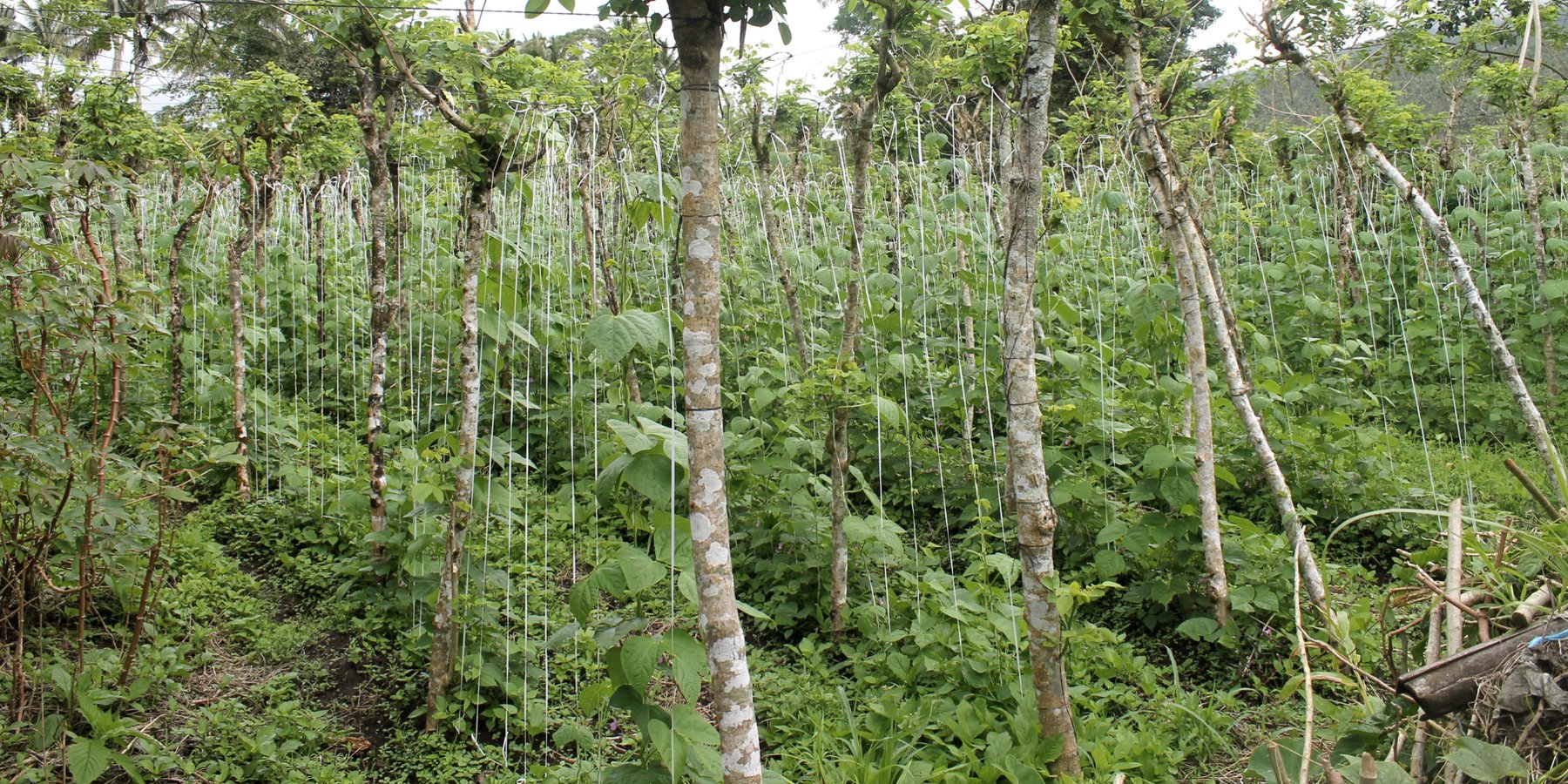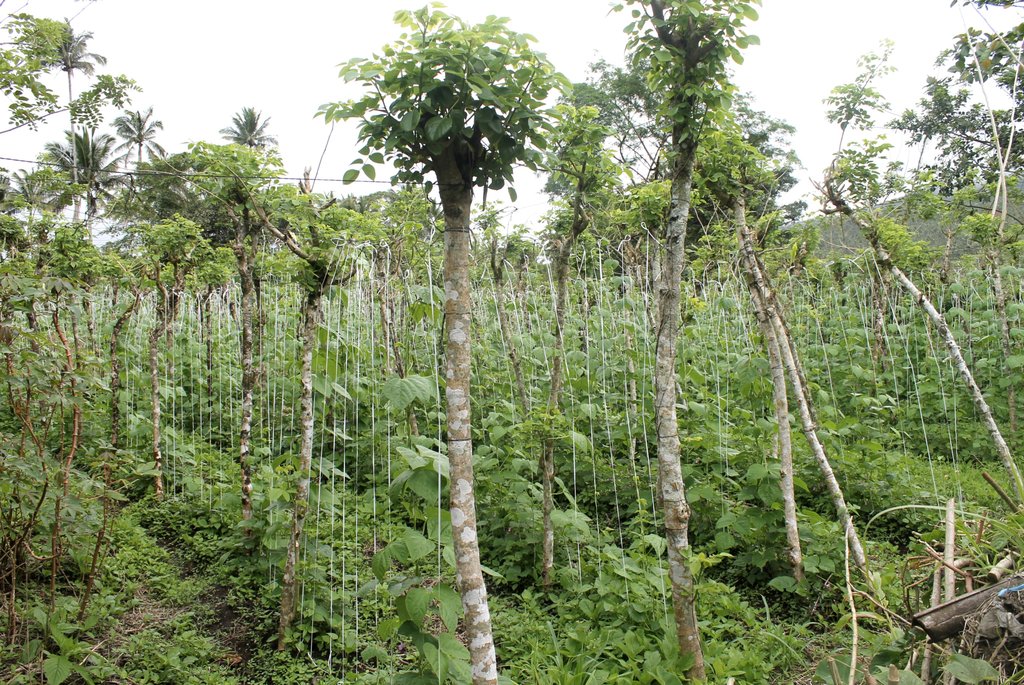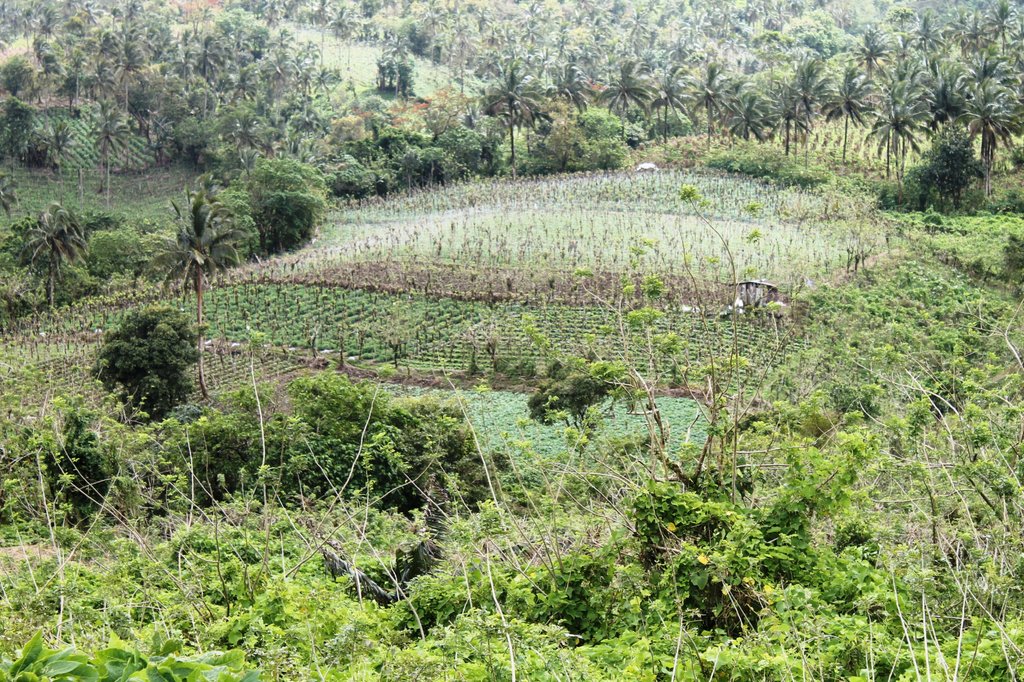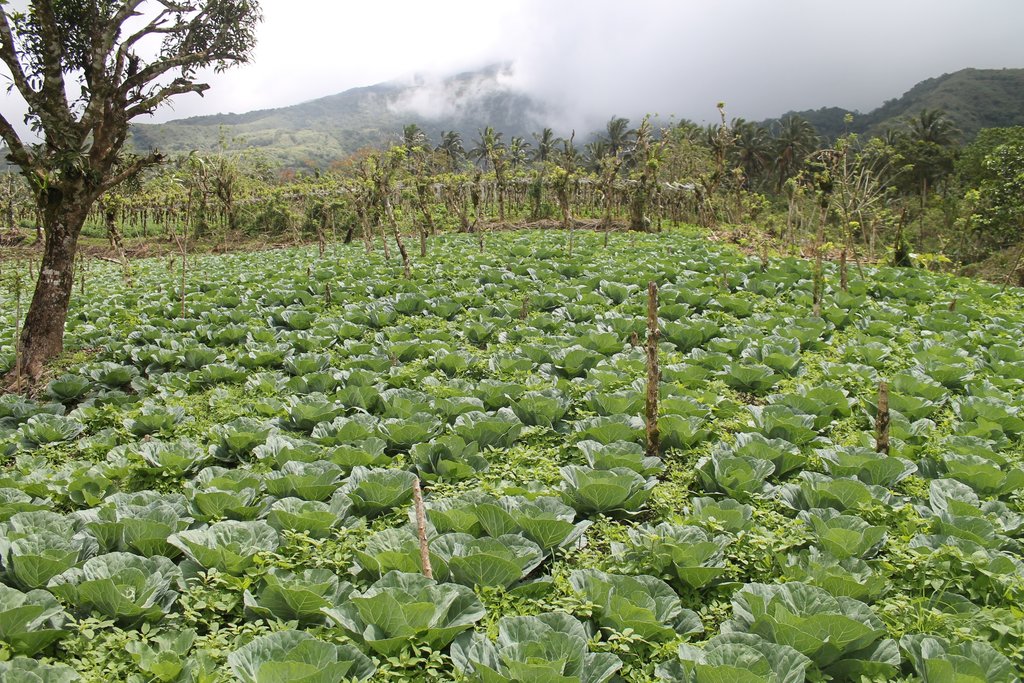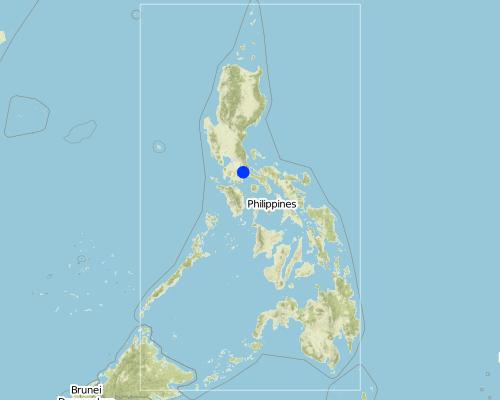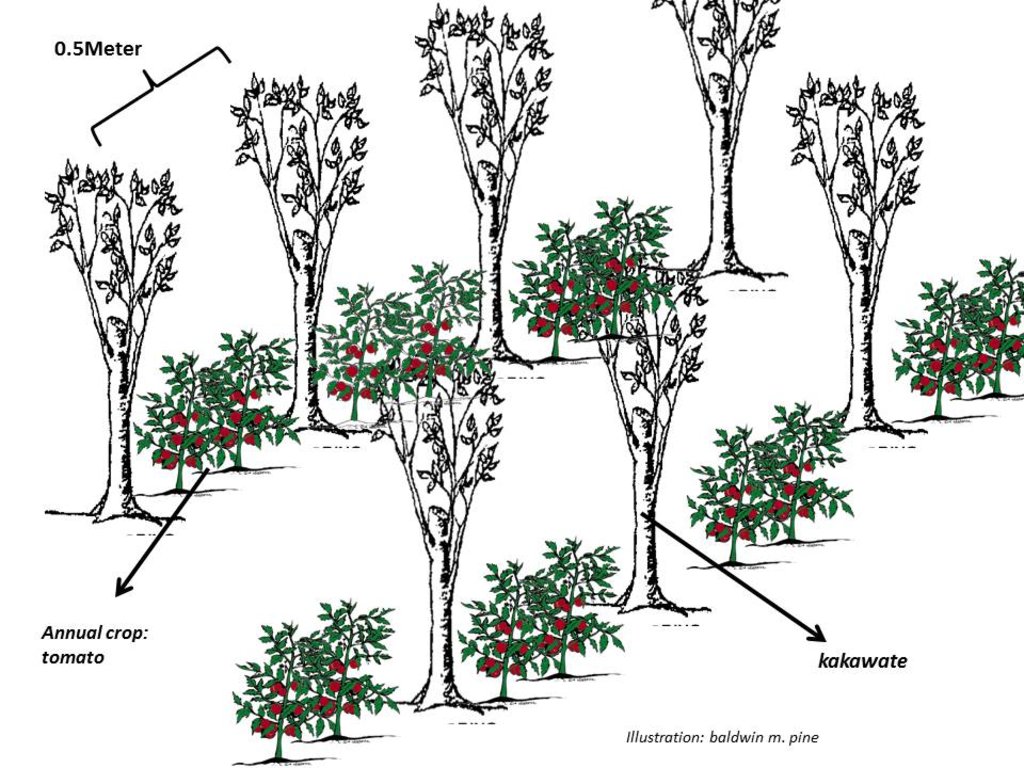Highly Diversified Cropping in Live Trellis System [Philippines]
- Création :
- Mise à jour :
- Compilateur : Philippine Overview of Conservation Approaches and Technologies
- Rédacteur : –
- Examinateur : Ursula Gaemperli
Kakawate as live trellis "balag"
technologies_1930 - Philippines
Voir les sections
Développer tout Réduire tout1. Informations générales
1.2 Coordonnées des personnes-ressources et des institutions impliquées dans l'évaluation et la documentation de la Technologie
Personne(s)-ressource(s) clé(s)
exploitant des terres:
Urriza Girlie
Brgy, Bukal, Nagcarlan, Laguna
Philippines
Spécialiste GDT:
Dela Pena Calixto
Local Government of Nagcarlan, Laguna
Nagcarlan, Laguna
Philippines
Soil Specialist / GIS Specialist:
Pine Baldwin
baldwinmp@gmail.com
Bureau of Soils and Water Management
Quezon City
Philippines
Engineer:
Raquid Jemar
Bureau of Soils and Water Management
Quezon City
Philippines
Engineer:
Torino Mharicar
Bureau of Soils and Water Management
Quezon City
Philippines
Engineer:
Tayao Aries
Bureau of Soils and Water Management
Quezon City
Philippines
Nom du projet qui a facilité la documentation/ l'évaluation de la Technologie (si pertinent)
Decision Support for Mainstreaming and Scaling out Sustainable Land Management (GEF-FAO / DS-SLM)Nom du ou des institutions qui ont facilité la documentation/ l'évaluation de la Technologie (si pertinent)
Bureau of Soils and Water Management (Bureau of Soils and Water Management) - Philippines1.3 Conditions relatives à l'utilisation par WOCAT des données documentées
Quand les données ont-elles été compilées (sur le terrain)?
03/03/2017
Le compilateur et la(les) personne(s) ressource(s) acceptent les conditions relatives à l'utilisation par WOCAT des données documentées:
Oui
1.4 Déclaration sur la durabilité de la Technologie décrite
Est-ce que la Technologie décrite ici pose problème par rapport à la dégradation des terres, de telle sorte qu'elle ne peut pas être déclarée comme étant une technologie de gestion durable des terres?
Non
2. Description de la Technologie de GDT
2.1 Courte description de la Technologie
Définition de la Technologie:
Gliricidia sepium locally known as "kakawate" served as live trellis / or anchorage for annual crops (mostly creeping-type vegetables) and erosion control measure. The technology is well-adopted in the community providing immediate food for the farmers and increased income due to diversified farming.
2.2 Description détaillée de la Technologie
Description:
The Highly Diversified Cropping in Live Trellis System is a traditional or local farmers' initiative technology widely practiced in Brgy. Bukal, Nagcarlan, Laguna situated in the area of Mt. Banahaw. The area with rolling to hilly terrain is receiving an annual rainfall of 1000-2000 mm. Each of the farmers who practiced the technology has 0.5 to 1.0 ha production area. Moreover, the community is accessible to infrastructures such as schools and market. Soils in the area is relatively good for agriculture cultivation.
Kakawate, a small to medium-sized, thornless tree which usually attains a height of 10-12 m is being used as live trellis or "balag" to various annual crops such as tomato, cucumber, chayote, beans, and ampalaya in the community. The cropping system is highly diversified since crop rotation is being practiced throughout the year. Aside from being an anchorage for annual crops, kakawate also stabilizes sloping lands and reduces soil erosion due to its strong roots which can grow 3-5 meters laterally, thereby holding the soil firmly. They are planted in a row of approximately 2-3 meters making it more effective in preventing soil erosion. Furthermore, kakawate is being trimmed and maintained every 3-6 months or as needs arise to a approximate 3 meters high as live trellis, the trimmed leaves are very rich in nitrogen and will eventually serve as compost or crop cover. These will help in improving soil quality and moisture in the soil. In addition, kakawate has multiple uses and benefits; they can serve as hardwood or firewood when matured, as materials in making furniture and anchorage for flowering plants like orchids.
In establishing the live trellis system, kakawate trunks/or cuttings "quick sticks" with at least 2-meter height are planted in a row. An estimate of 0.5 to 1 meter planting distance within a row and also between rows is used. When the kakawate trunks are already set up and planted, they are interconnected using a metallic wires. Along these wires, plastic straws are tied in a vertical position whereby crops can utilize this straws for creeping/ climbing . Finally, the desired crop will be planted according to their cropping pattern. Maintenance of the technology includes: weeding and trimming. During infestation, application of pesticide is done but in minimal.
The technology requires manual works resulting to elimination of machines that contributes to soil compaction.
The technology has been a practice in the community for a long time, and land users continue to adopt the technology because of it's easiness and inexpensiveness to establish, and low cost in terms of maintenance activity. Adding up to this is the variety of plants to be grown, making their market more profitable.
Gliricidia normally grows in tropical countries like the Philippines and is being utilized as hedgerows for erosion control measures. Over the years, its effectiveness as erosion control is known, and an increasingly used forage crop in cut-and-carry systems.
2.3 Photos de la Technologie
2.5 Pays/ région/ lieux où la Technologie a été appliquée et qui sont couverts par cette évaluation
Pays:
Philippines
Région/ Etat/ Province:
Laguna
Autres spécifications du lieu:
Brgy. Bukal, Nagcarlan
Map
×2.6 Date de mise en œuvre de la Technologie
Indiquez l'année de mise en œuvre:
1950
Si l'année précise est inconnue, indiquez la date approximative: :
- il y a plus de 50 ans (technologie traditionnelle)
2.7 Introduction de la Technologie
Spécifiez comment la Technologie a été introduite: :
- grâce à l'innovation d'exploitants des terres
- dans le cadre d'un système traditionnel (> 50 ans)
3. Classification de la Technologie de GDT
3.1 Principal(aux) objectif(s) de la Technologie
- améliorer la production
- réduire, prévenir, restaurer les terres dégradées
- préserver l'écosystème
- protéger un bassin versant/ des zones situées en aval - en combinaison avec d'autres technologies
- conserver/ améliorer la biodiversité
- réduire les risques de catastrophes
- s'adapter au changement et aux extrêmes climatiques et à leurs impacts
- créer un impact économique positif
- créer un impact social positif
3.2 Type(s) actuel(s) d'utilisation des terres, là où la Technologie est appliquée

Terres cultivées
- Cultures annuelles
Principales cultures (vivrières et commerciales):
Sayote, beans, tomato, cabbage,lettuce

Mixte (cultures/ pâturages/ arbres), incluant l'agroforesterie
- Agroforesterie
Principaux produits/ services:
Kakawate
3.3 Informations complémentaires sur l'utilisation des terres
Approvisionnement en eau des terres sur lesquelles est appliquée la Technologie:
- pluvial
Nombre de période de croissance par an: :
- 3
Précisez:
Cabbages and lettuce can be harvested three times a year.
3.4 Groupe de GDT auquel appartient la Technologie
- agroforesterie
- Amélioration de la couverture végétale/ du sol
- gestion intégrée de la fertilité des sols
3.5 Diffusion de la Technologie
Spécifiez la diffusion de la Technologie:
- répartie uniformément sur une zone
Si la Technologie est uniformément répartie sur une zone, indiquez la superficie couverte approximative:
- 1-10 km2
Commentaires:
Most of the farmers in the community adopt the technology
3.6 Mesures de GDT constituant la Technologie

pratiques agronomiques
- A1: Couverture végétale/ du sol
- A2: Matière organique/ fertilité du sol
- A3: Traitement de la couche superficielle du sol

pratiques végétales
- V1: Couverture d’arbres et d’arbustes
3.7 Principaux types de dégradation des terres traités par la Technologie

érosion hydrique des sols
- Wt: perte de la couche superficielle des sols (couche arable)/ érosion de surface
- Wo: effets hors-site de la dégradation
3.8 Prévention, réduction de la dégradation ou réhabilitation des terres dégradées
Spécifiez l'objectif de la Technologie au regard de la dégradation des terres:
- prévenir la dégradation des terres
- réduire la dégradation des terres
4. Spécifications techniques, activités, intrants et coûts de mise en œuvre
4.1 Dessin technique de la Technologie
4.2 Spécification/ explications techniques du dessin technique
Kakawate cuttings are planted with an estimated planting distance of 0.5 m to 1 m. They are trimmed and maintained at around 3 meters high for every 3-6 months or as needs arise. In between the kakawate are annual crops like tomato, chayote, beans,cucumber, lettuce and cabbages which are planted in rotation depending on the season.
4.3 Informations générales sur le calcul des intrants et des coûts
Spécifiez la manière dont les coûts et les intrants ont été calculés:
- par superficie de la Technologie
Indiquez la taille et l'unité de surface:
0.5 hectare
autre/ monnaie nationale (précisez):
Philippine Peso (Php)
Indiquer le taux de change du dollars en monnaie locale (si pertinent): 1 USD= :
50,0
Indiquez le coût salarial moyen de la main d'œuvre par jour:
300
4.4 Activités de mise en place/ d'établissement
| Activité | Type de mesures | Calendrier | |
|---|---|---|---|
| 1. | Clearing of the area | Agronomique | As needs arise or before planting of kakawate and annual crops |
| 2. | Planting of kakawate cuttings | Végétale | |
| 3. | Installation of metal wire and plastic straws | Agronomique | |
| 4. | Planting of annual crop: tomato | Agronomique | First cropping usually from December to March |
| 5. | Planting of annual crop: cucumber or beans | Agronomique | After harvest of the 1st crop (tomato) usually from April to June |
| 6. | Planting of annual crop: chayote | Agronomique | After harvest of the second crop ( cucumber or beans) usually from July to December |
4.5 Coûts et intrants nécessaires à la mise en place
| Spécifiez les intrants | Unité | Quantité | Coûts par unité | Coût total par intrant | % des coût supporté par les exploitants des terres | |
|---|---|---|---|---|---|---|
| Main d'œuvre | Manual labour: Weeding | person-days | 3,0 | 300,0 | 900,0 | 100,0 |
| Main d'œuvre | Manual labour: Planting | person-days | 3,0 | 300,0 | 900,0 | 100,0 |
| Main d'œuvre | Manual labour: Fertilizer Application | person-days | 3,0 | 300,0 | 900,0 | 100,0 |
| Main d'œuvre | Manual labour: Harvesting and Hauling | person-days | 3,0 | 300,0 | 900,0 | 100,0 |
| Matériel végétal | Kakawate cuttings (cuttings are abundant in the area and not for sale) | 100,0 | ||||
| Matériel végétal | Tomato @ 100grams per can | can | 1,0 | 1950,0 | 1950,0 | 100,0 |
| Matériel végétal | Cucumber @ 100grams per can | can | 1,0 | 600,0 | 600,0 | 100,0 |
| Matériel végétal | Chayote (seeds are abundant in the area) | 100,0 | ||||
| Engrais et biocides | Inorganic fertilizer: Urea | bag | 5,0 | 1500,0 | 7500,0 | 100,0 |
| Engrais et biocides | Organic fertilizer: chicken dung | bag | 5,0 | 450,0 | 2250,0 | 100,0 |
| Engrais et biocides | Pesticide | bottle | 1,0 | 280,0 | 280,0 | 100,0 |
| Matériaux de construction | Metal wire ( can be used for a long time, up to 10 years life span | roll | 6,0 | 480,0 | 2880,0 | 100,0 |
| Matériaux de construction | Straw | roll | 10,0 | 100,0 | 1000,0 | 100,0 |
| Coût total de mise en place de la Technologie | 20060,0 | |||||
4.6 Activités d'entretien/ récurrentes
| Activité | Type de mesures | Calendrier/ fréquence | |
|---|---|---|---|
| 1. | Weeding | Agronomique | As needs arise but normally twice per cropping per crop |
| 2. | Trimming of kakawate | Végétale | As needs arise |
| 3. | Application of organic fertilizer | Agronomique | Once per cropping |
| 4. | Application of inorganic fertilizer | Agronomique | Twice per cropping |
| 5. | Spraying of pesticide | Agronomique | As needs arise |
4.7 Coûts et intrants nécessaires aux activités d'entretien/ récurrentes (par an)
| Spécifiez les intrants | Unité | Quantité | Coûts par unité | Coût total par intrant | % des coût supporté par les exploitants des terres | |
|---|---|---|---|---|---|---|
| Main d'œuvre | Weeding | person-days | 3,0 | 300,0 | 900,0 | 100,0 |
| Main d'œuvre | Trimming of kakawate | person-days | 3,0 | 300,0 | 900,0 | 100,0 |
| Main d'œuvre | Application of organic fertilizer | person-days | 3,0 | 300,0 | 900,0 | 100,0 |
| Main d'œuvre | Application of inorganic fertilizer | person-days | 3,0 | 300,0 | 900,0 | 100,0 |
| Equipements | Spraying of pesticide | person-days | 3,0 | 300,0 | 900,0 | 100,0 |
| Coût total d'entretien de la Technologie | 4500,0 | |||||
5. Environnement naturel et humain
5.1 Climat
Précipitations annuelles
- < 250 mm
- 251-500 mm
- 501-750 mm
- 751-1000 mm
- 1001-1500 mm
- 1501-2000 mm
- 2001-3000 mm
- 3001-4000 mm
- > 4000 mm
Spécifiez la pluviométrie moyenne annuelle (si connue), en mm:
1500,00
Spécifications/ commentaires sur les précipitations:
Rainfall is evenly distributed throughout the year
Zone agro-climatique
- humide
5.2 Topographie
Pentes moyennes:
- plat (0-2 %)
- faible (3-5%)
- modéré (6-10%)
- onduleux (11-15%)
- vallonné (16-30%)
- raide (31-60%)
- très raide (>60%)
Reliefs:
- plateaux/ plaines
- crêtes
- flancs/ pentes de montagne
- flancs/ pentes de colline
- piémonts/ glacis (bas de pente)
- fonds de vallée/bas-fonds
Zones altitudinales:
- 0-100 m
- 101-500 m
- 501-1000 m
- 1001-1500 m
- 1501-2000 m
- 2001-2500 m
- 2501-3000 m
- 3001-4000 m
- > 4000 m
5.3 Sols
Profondeur moyenne du sol:
- très superficiel (0-20 cm)
- superficiel (21-50 cm)
- modérément profond (51-80 cm)
- profond (81-120 cm)
- très profond (>120 cm)
Texture du sol (de la couche arable):
- grossier/ léger (sablonneux)
- fin/ lourd (argile)
Texture du sol (> 20 cm sous la surface):
- moyen (limoneux)
Matière organique de la couche arable:
- abondant (>3%)
- moyen (1-3%)
Si disponible, joignez une description complète du sol ou précisez les informations disponibles, par ex., type de sol, pH/ acidité du sol, capacité d'échange cationique, azote, salinité, etc.
pH is 6.59
5.4 Disponibilité et qualité de l'eau
Disponibilité de l’eau de surface:
bonne
Qualité de l’eau (non traitée):
eau potable
La salinité de l'eau est-elle un problème? :
Non
La zone est-elle inondée?
Non
5.5 Biodiversité
Diversité des espèces:
- élevé
Diversité des habitats:
- élevé
5.6 Caractéristiques des exploitants des terres appliquant la Technologie
Sédentaire ou nomade:
- Sédentaire
Orientation du système de production:
- mixte (de subsistance/ commercial)
- commercial/ de marché
Revenus hors exploitation:
- 10-50% de tous les revenus
Niveau relatif de richesse:
- moyen
Individus ou groupes:
- individu/ ménage
Niveau de mécanisation:
- travail manuel
Genre:
- femmes
- hommes
Age des exploitants des terres:
- personnes d'âge moyen
- personnes âgées
5.7 Superficie moyenne des terres détenues ou louées par les exploitants appliquant la Technologie
- < 0,5 ha
- 0,5-1 ha
- 1-2 ha
- 2-5 ha
- 5-15 ha
- 15-50 ha
- 50-100 ha
- 100-500 ha
- 500-1 000 ha
- 1 000-10 000 ha
- > 10 000 ha
Cette superficie est-elle considérée comme de petite, moyenne ou grande dimension (en se référant au contexte local)?
- petite dimension
5.8 Propriété foncière, droits d’utilisation des terres et de l'eau
Propriété foncière:
- individu, avec titre de propriété
Droits d’utilisation des terres:
- individuel
Droits d’utilisation de l’eau:
- individuel
5.9 Accès aux services et aux infrastructures
santé:
- pauvre
- modéré
- bonne
éducation:
- pauvre
- modéré
- bonne
assistance technique:
- pauvre
- modéré
- bonne
emploi (par ex. hors exploitation):
- pauvre
- modéré
- bonne
marchés:
- pauvre
- modéré
- bonne
énergie:
- pauvre
- modéré
- bonne
routes et transports:
- pauvre
- modéré
- bonne
eau potable et assainissement:
- pauvre
- modéré
- bonne
services financiers:
- pauvre
- modéré
- bonne
6. Impacts et conclusions
6.1 Impacts sur site que la Technologie a montrés
Impacts socio-économiques
Production
production agricole
Commentaires/ spécifiez:
An increase in production due to crop diversification
qualité des cultures
Commentaires/ spécifiez:
Organic farming is a common practice in the community, and with this, it aids in the development of crop quality.
production fourragère
Commentaires/ spécifiez:
Kakawate are being utilized as forage crop for ruminants in the area.
qualité des fourrages
Commentaires/ spécifiez:
Kakawate is rich in Nitrogen.
production de bois
Commentaires/ spécifiez:
Kakawate when matured can be utilized as firewood and materials for making furnitures.
diversité des produits
Commentaires/ spécifiez:
Crop rotation makes the technology diverse.
surface de production
Commentaires/ spécifiez:
The area is maximized for cultivation at a minimum soil disturbance.
gestion des terres
Revenus et coûts
dépenses pour les intrants agricoles
Commentaires/ spécifiez:
The application of inorganic fertilizer is minimal due to organic farming.
revenus agricoles
Commentaires/ spécifiez:
Farmers' income is increased due to crop diversicification
diversité des sources de revenus
Commentaires/ spécifiez:
Farmers' income is increased due to crop diversicification.
Impacts socioculturels
sécurité alimentaire/ autosuffisance
connaissances sur la GDT/ dégradation des terres
Commentaires/ spécifiez:
The continued adoption of the technology testifies that SLM and/land degradation knowledge is improved in the community.
Impacts écologiques
Sols
humidité du sol
Commentaires/ spécifiez:
Kakawate when left on the ground aids in the improvement of soil moisture.
couverture du sol
Commentaires/ spécifiez:
Crop rotation practice improves soil cover.
perte en sol
Commentaires/ spécifiez:
Over the years, kakawate is proven to be an effective erosion control measure in the sloping areas.
compaction du sol
Commentaires/ spécifiez:
Manual cultivation aids in minimal disturbance of the soil, thereby does not contribute to soil compaction in the area.
matière organique du sol/ au dessous du sol C
Commentaires/ spécifiez:
Organic farming is a practice in the community.
Biodiversité: végétale, animale
Couverture végétale
contrôle des animaux nuisibles/ maladies
Commentaires/ spécifiez:
Crop rotation helps in the decreased of pest population.
Réduction des risques de catastrophe et des risques climatiques
glissements de terrains/coulées de débris
émissions de carbone et de gaz à effet de serre
Commentaires/ spécifiez:
The technology requires manual cultivation with least or no machine intervention, organic farming is a must with minimum usage of inorganic fertilizer, and biodiversity is also encourage. With that, the technology is believed to be effective to address carbon emission and greenhouse gases.
6.2 Impacts hors site que la Technologie a montrés
inondations en aval
6.4 Analyse coûts-bénéfices
Quels sont les bénéfices comparativement aux coûts de mise en place (du point de vue des exploitants des terres)?
Rentabilité à court terme:
positive
Rentabilité à long terme:
positive
Quels sont les bénéfices comparativement aux coûts d'entretien récurrents (du point de vue des exploitants des terres)?
Rentabilité à court terme:
positive
Rentabilité à long terme:
positive
6.5 Adoption de la Technologie
- plus de 50%
Si disponible, quantifiez (nombre de ménages et/ou superficie couverte):
Almost all of local farmers practice the technology
Parmi tous ceux qui ont adopté la Technologie, combien d'entre eux l'ont fait spontanément, à savoir sans recevoir aucune incitation matérielle ou aucun paiement?
- 90-100%
6.6 Adaptation
La Technologie a-t-elle été récemment modifiée pour s'adapter à l'évolution des conditions?
Non
6.7 Points forts/ avantages/ possibilités de la Technologie
| Points forts/ avantages/ possibilités du point de vue de l'exploitant des terres |
|---|
|
(1) Increase farm income (2) Diverse farm produce (3) Easiness to establish, no need for technical knowledge to establish (4) Inexpensive (4) Organic farming |
| Points forts/ avantages/ possibilités du point de vue du compilateur ou d'une autre personne ressource clé |
|---|
|
(1) Low production cost (2) Easiness to maintain (3) Effective erosion control measure (4) Increase farm yield and income (5) Diverse farm produce (6) Easiness to transfer |
6.8 Faiblesses/ inconvénients/ risques de la Technologie et moyens de les surmonter
| Faiblesses/ inconvénients/ risques du point de vue de l’exploitant des terres | Comment peuvent-ils être surmontés? |
|---|---|
| (1) Pest infestation | (1) Pesticide application |
| Faiblesses/ inconvénients/ risques du point de vue du compilateur ou d'une autre personne ressource clé | Comment peuvent-ils être surmontés? |
|---|---|
| (1) The technology is very good in terms of erosion control and improving lives of farmers in the community, but then the technology is not well-known for the whole country. | (1). The WOCAT database as an excellent information tool /or medium in the dissemination of this kind of technology, not only within Philippines but all over the world. These would highlight initiatives of the local farmers situated in remote areas in terms of managing the land productively and sustainably. |
7. Références et liens
7.1 Méthodes/ sources d'information
- visites de terrain, enquêtes sur le terrain
Two infomants: Local Government Unit (LGU) technical staff and the land owner
- interviews/entretiens avec les exploitants des terres
Two infomants: LGU technical staff and the land owner
- interviews/ entretiens avec les spécialistes/ experts de GDT
One LGU technical staff
Liens et modules
Développer tout Réduire toutLiens
Aucun lien
Modules
Aucun module trouvé


